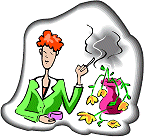| |
  
Locate, Identify And Label Your Poisonous Products
Gather a few of the many bottles you probably have around your house: one for dishes, one for laundry, one for cleaning the bathroom, one for cleaning floors, one for windows. Look for the words CAUTION, WARNING or DANGER. These are signal words required by law for products containing harmful ingredients. Do you know what they mean?
| CAUTION | An ounce to a pint may be fatal or harmful if swallowed, inhaled or absorbed through the skin by an adult 180-pound man. |
| WARNING | A teaspoon to an ounce may be fatal or harmful if swallowed, inhaled or absorbed through the skin by an adult 180-pound man. |
| DANGER | A taste to a teaspoon is fatal if swallowed, inhaled or absorbed through the skin by an adult 180-pound man. |
Just think, if these amounts are fatal to a 180-pound man, what effect could it have on a child or a small woman?
Wouldn't it be great to have products with NO warning labels?
Unfortunately, the best we can seem to do is CAUTION. Most health food store household cleaning brands have the label CAUTION. Even Basic-H® from Shaklee has a CAUTION label. Remember, CAUTION 's amounts are an ounce to a pint, so there are safer choices even within the CAUTION category.
If there is a WARNING or DANGER label, or rubber gloves and/or a mask are required, that is a warning sign that the use of this product should be as a last resort. If you must, be sure to follow all directions, especially those regarding ventilation. For example, one of these powerful cleaners that requires a "well-ventilated area" would not be appropriate to use to clean an elevator. And yet that very practice is occuring daily in thousands of buildings across the country.
Me? I DON'T BUY, USE OR STORE THOSE PRODUCTS. Just having them sitting around the house is toxic! So, I look for healthier alternatives. And now I am sharing my research with you on this site; my choices for some of the best in the non-toxic world.
And P.S. I have found a product that requires NO warning label. Not even CAUTION. You'll hear a lot about it on this site, because I am very excited to find such a fine, safe and versatile product.
Watch out for these ingredients
Look at the ingredients on your products. These ingredients have been deemed "generally safe" in small amounts by our government, that's why they can be sold in your grocery store. But under your sink they are outgassing their containers and mixing together with each other in a chemical soup. Do you really think that toxic air stays inside your cupboard? How many hours of the day do you spend standing at that sink or nearby and inhaling those fumes? (Have you ever walked by a janitor's closet? Ugh.)
Here are some common ingredients of commercial household products:
| Ammonia | Fatal when swallowed |
| Ammonium Hydroxide | Corrosive, irritant |
| Bleach | Potentially fatal if ingested |
| Chlorine | Number one cause of poisonings in children |
| Formaldehyde | Highly toxic; known carcinogen |
| Hydrochloric acid | Corrosive, eye and skin irritant |
| Hydrochloric bleach | Eye, skin and respiratory tract irritant |
| Lye | Severe damage to stomach and esophagus if ingested |
| Naphtha | Depresses the central nervous system |
| Nitrobenzene | Causes skin discoloration, shallow breathing, vomiting, and death |
| Perchlorethylene | Damages liver, kidney, nervous system |
| Petroleum Distillates | Highly flammable; suspected carcinogen |
| Phenol | Extremely dangerous; suspected carcinogen; fatal taken internally |
| Propylene Glycol | Immunogen; main ingredient in antifreeze |
| Sodium hypochlorit | Potentially fatal |
| Sodium laurel sulfate | Carcinogen, toxin, genetic mutagen |
| Sodium tripolyphosphate | Irritant |
| Trichloroethane | Damages liver and kidneys |
Some interesting factoids
- In the past 40 years, at least 70,000 new chemicals have been released into the environment through new consumer and industrial products and food.
- Male and female infertility are on the rise. Research is now pointing to pesticides as a viable cause.
- Women who work in the home have a 54% higher death rate than women who work out of the home. - Toronto Indoor Air Conference, 1990
- Each year more than 50 million Americans suffer from allergic diseases. Allergies are the sixth leading cause of chronic disease in the US, costing the health care system $18 billion annually. The prevalence of allergic rhinitis (inflamed nasal membranes) has increased substantially over the past 15 years.
- Asthma ranks among the most common chronic conditions in the United States, affecting an estimated 14.9 million persons.
- According to the U.S Poison Control Centers, "A child is accidentally poisoned every 30 seconds and more than 50% of all poisonings occur at home with children under 5 years of age."
- Asthma is the #1 cause of absenteeism in schools.
- There has been a 25% increase in the last 25 years in cancer incidence among children under 15 years of age.
- ADD/ADHD is the most commonly diagnosed childhood behavior disorder today. More than two million (3-5%) children have ADD.
- Thirty years ago the 3 major childhood illnesses were chickenpox, measles and mumps. Now it is asthma, ADD and cancer.
- Brain cancer in children is up 40% in 20 years.

Indoor Air Quality
The Environmental Protection Agency states that studies have found that levels of several VOCs (Volatile Organic Compounds) "average 2 to 5 times higher indoors than outdoors." In other words, open the window whenever possible. (Which begs the question: how can office buildings and hotels with windows that don't open be beneficial for anyone's health?)
Read about Sources of Indoor Air Pollution on the EPA site.
Read this EPA study on the high amounts of pesticides found in American homes.
Here's the EPA's advice on Improving Your Indoor Air Quality which basically boils down to source control, improved ventilation, and air cleaners. Healthycleaning.com is about addressing the source control and providing healthier alternatives.
Do you need antibacterial products?
This article is online at ABC Science News site.
According to Reuters, a briefing sponsored by the American Medical Association [in May, 2000] heard that people should not only stop over-using antibiotics, but should also stop buying anti-bacterial soaps and detergents which can also build up bacterial resistance.
According to Dr. Stuart Levy of Tufts University, the aim of washing and rinsing in the home is to wash the bacteria away and the addition of a bug-killing agent does not accelerate the process. Antibacterial soaps, he argues, work well in hospitals, used under controlled conditions, because time was needed to actually kill the bacteria.
Australian microbiologist, Dr John Turnidge of Adelaide Women and Children's Hospital agrees with Levy's concerns.
"The sale of these antibacterial soaps and detergents preys on people's fears of bacteria. They're really not necessary since soaps and detergents help reduce the risk from bacteria anyway," he told the ABC. "It's really a mild kind of fraud. There's no proven benefits, and all the available evidence suggests it could be detrimental."
Dr Turnidge said that antibacterial products could increase the chance of bacteria developing resistance to antibiotics, through a process known as co-selection.
E. coli, for example, caries resistance genes to four or five antibiotics. If we use any one of those antibiotics, we select for the resistance genes to all these antibiotics. If these antibiotic resistant E. coli develop resistance to antibacterial household products as well, then every time we use the product, we will select for the antibiotic resistance genes as well.
"We have patients dying of infectious diseases because some of the hundreds of antibiotics we have are not working," Levy said, citing the overuse of antibiotics and popular antibacterial products as a threat.
"We are getting our antibiotic soap, our detergent, or pyjamas," Levy said. "It is a rage."
An investigation in Australia by CHOICE Magazine found a rash of antibacterial products on the market including kitchen wipes, cloths, sponges, kitchen sprays, handwash, dishwashing liquids, toilet disinfectant, garbage bags, cling wrap and chopping boards.
According to Reuters, two years ago Levy's lab at Tufts found that E. coli bacteria can develop resistance to triclosan, one of the common antibacterial ingredients in store-bought soaps. The lab found that triclosan acts on a single gene in the bacteria to kill it. They also found that tuberculosis has a similar gene - and it is the same gene that one tuberculosis drug targets.
Levy's group says it is possible that overuse of triclosan could lead to the rise of a new drug-resistant form of tuberculosis.
|
Stuff to get rid of
The afore-mentioned cleaning products
Candles, especially scented
Commercial laundry detergent, especially those with added fragrances
Dryer sheets and commercial fabric softener
Drain cleaners (a plumber is better, anyway)
Perfume, aftershave, scented soaps, shower body washes, etc., etc.
Anti-bacterial ANYTHING
Potpourri, Air fresheners, Incense
Pesticides, Herbicides
| |
How to dispose of household chemicals
I hope that reading this material has convinced you to clean out your bathroom cupboard, under the kitchen sink, on that shelf in the garage - everywhere you are storing toxic material outgassing to spread that feeling of general malaise that has seemed to settle over this country.
When you get ready to box that stuff up and cart it away, here's what you must do, according to the EPA.
The good news is...
 There are alternatives. There are small companies out there making products that are safer for you and your family. You will notice a difference in your health and your general well-being if you remove the sources of indoor air polution as much as possible from your life.
There are alternatives. There are small companies out there making products that are safer for you and your family. You will notice a difference in your health and your general well-being if you remove the sources of indoor air polution as much as possible from your life.
Click below to explore the alternatives:
|
|


 There are alternatives. There are small companies out there making products that are safer for you and your family. You will notice a difference in your health and your general well-being if you remove the sources of indoor air polution as much as possible from your life.
There are alternatives. There are small companies out there making products that are safer for you and your family. You will notice a difference in your health and your general well-being if you remove the sources of indoor air polution as much as possible from your life.